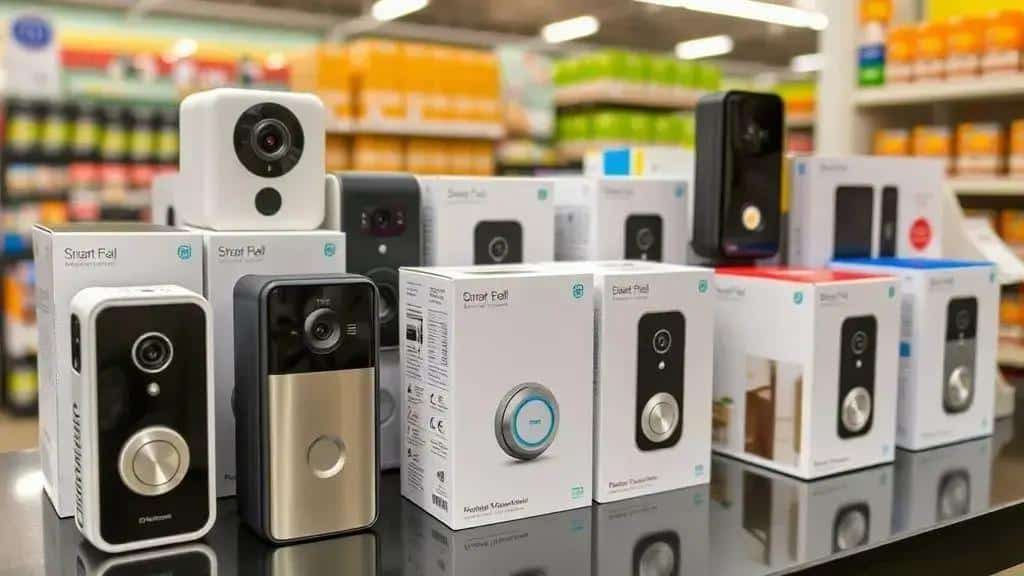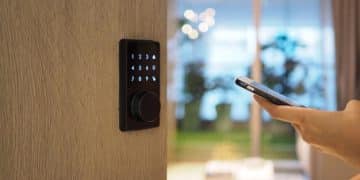In-depth review of smart doorbells: find your perfect match

An in-depth review of smart doorbells reveals their key features, such as video quality and security, while discussing the pros, cons, and installation tips for optimal performance.
If you’ve been considering upgrading your home security, an in-depth review of smart doorbells could guide you in choosing the perfect solution. Are they truly worth the investment? Let’s find out together.
Understanding smart doorbells: how they work
Understanding how smart doorbells work is essential in today’s tech-savvy world. These devices not only enhance home security but also add convenience to your daily routine. Let’s explore how they function and what features make them stand out.
Key Components of Smart Doorbells
Smart doorbells typically include a camera, a microphone, speakers, and sometimes motion sensors. These components work together to provide a seamless experience.
Here’s how they operate:
- Camera: Enables video recording and real-time viewing.
- Microphone: Allows two-way audio communication.
- Motion Sensors: Detect movement and send alerts to your smartphone.
When someone approaches your door, the motion sensors detect their presence, triggering the camera to record. You can view the live feed on your smartphone from anywhere, ensuring you never miss a visitor.
How Smart Doorbells Connect
Smart doorbells connect to your home Wi-Fi network, making it easy to monitor activity remotely via a dedicated app. This connectivity allows users to receive alerts, see who’s at the door, and even communicate with visitors without opening the door. If someone rings the bell, you receive a notification on your phone, so you can respond immediately.
The integration with smart home systems amplifies their functionality. For example, you can link your smart doorbell to other smart devices, such as lights or security cameras, to create a more comprehensive security solution for your home.
Moreover, many smart doorbells come equipped with cloud storage options, meaning you can save video footage for future reference. This feature is particularly useful if you need to keep an eye on package deliveries or to review any suspicious activity.
Key features to consider when buying

When choosing a smart doorbell, it’s essential to consider various features that will enhance your home’s security and convenience. Many options are available, each with unique benefits that suit different needs.
Video Quality and Field of View
One of the most important aspects of a smart doorbell is its video quality. Look for devices that offer at least 1080p resolution for clear images. The field of view is also crucial; a wider angle allows you to see more of your porch area. A field of view of 160 degrees or more is ideal.
Night Vision
Another vital feature is night vision. A good smart doorbell should have infrared capabilities to ensure you can see who is at your door, even in low-light conditions. This feature is particularly useful for nighttime deliveries or visitors.
- Infrared LEDs: These help illuminate the scene without disturbing your neighbors.
- Black-and-white video: Provides clear images in dark settings.
- Color night vision: Some models offer this feature for better visibility.
Moreover, consider your connectivity options. Many smart doorbells connect via Wi-Fi, but some models may also support Ethernet for more stable connections. Depending on your home setup, you might prefer one method over another.
Storage and Subscription Plans
Storage options matter, too. Many smart doorbells offer cloud storage for video footage, but this often requires a subscription. Check the amount of free storage available and the prices for additional storage plans. Some devices provide local storage options via an SD card, which can save you from ongoing fees.
Battery life is another consideration. Depending on whether your smart doorbell is hardwired or battery-operated, performance can vary. A wired device may require less maintenance, while a well-designed battery-operated doorbell can last several months on a single charge.
Pros and cons of smart doorbells
The pros and cons of smart doorbells are essential to understand before making a purchase. These devices offer many benefits, but some drawbacks are worth considering as well.
Pros of Smart Doorbells
One of the main advantages is enhanced security. With features like motion detection and remote viewing, you can monitor your home at any time. This level of control adds peace of mind.
- Immediate Alerts: Receive notifications on your smartphone when someone is at your door.
- Two-Way Audio: Talk to visitors or delivery personnel directly using your phone.
- High-Quality Video: Many devices offer HD video with night vision, making it easy to see details.
Another major benefit is convenience. Smart doorbells let you interact with guests without needing to answer the door. This feature is especially handy when you’re busy or not at home.
Cons of Smart Doorbells
Despite their advantages, there are also some drawbacks. One concerning factor is privacy. Since smart doorbells record video and audio, they can raise privacy issues for you and your neighbors.
- Data Security: Hacking is a risk, so you must ensure you use strong passwords.
- Subscription Costs: Many services require monthly fees for cloud storage.
- Installation: Some models can be complex to install without professional help.
Also, smart doorbells are dependent on Wi-Fi. If your internet connection is weak or goes down, the features may not work correctly. In such cases, you could miss important alerts or footage.
Installation tips for smart doorbells

Installing a smart doorbell can seem daunting, but with the right tips, you can make the process smooth and straightforward. Proper installation ensures that your device performs optimally and provides the security you need.
Gather the Right Tools
Before starting, you should gather all necessary tools. This typically includes a screwdriver, drill, level, and a smartphone for setup. Having everything ready will save you time and frustration.
Check Your Wi-Fi Signal
A reliable Wi-Fi connection is essential for your smart doorbell to work effectively. Measure the Wi-Fi strength at your door’s location using your smartphone. If the signal is weak, you might need a Wi-Fi extender.
- Use a Wi-Fi extender: Boost signals in harder-to-reach areas.
- Skip interference: Avoid placing the doorbell near large electronic devices.
- Test your speed: Ensure that your internet speed meets the doorbell’s requirements.
Once your signal is strong, proceed with the physical installation. Read the instructions carefully to understand the mounting options.
Wiring or Battery Installation
Smart doorbells can either be hardwired or battery-operated. If you opt for a hardwired connection, make sure to turn off the power at the breaker before starting. Connect the wires according to the manufacturer’s guidelines.
In the case of a battery-operated model, install the batteries as directed. Make sure they are securely in place to avoid future issues.
After installation, test the doorbell to ensure it’s functioning correctly. Press the button and check the link to your smartphone app. This way, you can confirm that you receive alerts and can view the video feed as expected.
Lastly, consider adjusting the camera angle for optimal viewing. Aim to capture the path leading to your front door and ensure you can see visitors clearly.
FAQ – Frequently Asked Questions about Smart Doorbells
What features should I look for in a smart doorbell?
Key features include video quality, night vision, two-way audio, and a strong Wi-Fi connection.
Are smart doorbells easy to install?
Yes, most smart doorbells come with clear instructions and can be installed by homeowners with basic tools.
Do I need a subscription for cloud storage with my smart doorbell?
Many smart doorbells offer free storage; however, some may require a subscription for extended features.
How do smart doorbells enhance home security?
They provide real-time video feeds, alerts for visitors, and the ability to communicate with anyone at your door remotely.





